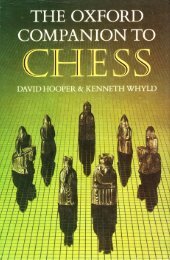You also want an ePaper? Increase the reach of your titles
YUMPU automatically turns print PDFs into web optimized ePapers that Google loves.
T66 KING HUNT<br />
encmy man. and has onc spcciat movc, cAsrrrNc.<br />
In a corner the king atlacks three squares,<br />
else*here on tbe edge five squares, away from the<br />
edgecigntsquares. ln theairaywhite stingsta.ds<br />
KING'S CAMBIT, 55,1, one ol the oldest openinss.<br />
eilen <strong>by</strong> ruc.NA. while uses his lpa{n ro<br />
exert pressure on the cenke and, terhaps, ro opcn<br />
lhe tlile <strong>to</strong>r hn king s rook. By means of the<br />
cr.Ass,cAr. DrFrNcr. 555. or th<br />
r;AMBr.559, Black maydecli.c thc eambit. Morc<br />
Irequendy be accepts. 564, alter Nbich rhe (N6's<br />
NrGEr cAMBrr n the nosr PoPular continuation<br />
ahhough not dcmonsirably hctlcr than thc n6nop's<br />
{rAMBr or lhe r6sL( BlsHop s 6AMur.<br />
<strong>The</strong> nosl connonly played openines during lhe<br />
18fi century seen 10 have been the TTALAN<br />
op.NrNG. thc n6nop's opENrxcj and rhc King\<br />
Gambii Accpied i yet co.temporary sriters. with<br />
the e&eption otpsrlDon, considered the ganbit<br />
unsound. Doubtlcss its livcly possibiliiics serc<br />
atlra.tivc, and ir remained popular Nell inlo lhe<br />
19th ce.tury. cossrs and LPscsnrz, in Crc$<br />
plaln s Munuul 118138), eiee 265 pages ol variations<br />
sirhout arriving at any firm conclusion as <strong>to</strong><br />
ibc meril oflhn gambil. Out ol lashion since lhe<br />
1890s, it is still played occasionally <strong>by</strong> masters:<br />
their ains are sraresic, as adlised bv Philidor,<br />
<strong>The</strong> tings salely is tbe ukimale objecr ol the<br />
game. <strong>The</strong>oretically tbeonlyway <strong>to</strong> win is <strong>to</strong> make<br />
i1 inpo$ible lor the opponent\ ting ro evade<br />
capturcj bur thc kine h ncvcrrakcn: thcgameends<br />
<strong>by</strong> checkma te when capture sould be ineviiable on<br />
the.ext 6ove. (see also STALEM{E.)<br />
Usually thc tallest piccc and sonetimes bearing<br />
a crown, ihe king has alsays bccn thc mosl<br />
impo ant ol the pieces. As far as is knoNn its basic<br />
move has .or changed. In the 13lb cenrury,<br />
hosever, thc kingwas pcrmittcd oncc in a gane lo<br />
make aleap. and fron this the move ofcastlingwas<br />
developed. King n a ranslation oI shah. the<br />
Pesian word lor the piece.<br />
XINC EUNI, a se.ies oI moves in wbi.b a player<br />
chases akingaroundlhe board wilhcheckmate as<br />
his aim. (For cx<strong>amp</strong>lcs scc games under GUNSBERcrc1OI,<br />
ANd MAAHALL,)<br />
KrNG'S BISEOP CAMBIT, 567, usuauy caued lhe<br />
KING'S FIANCIIETIO OPENING, 696, move<br />
dating Iron LUCNA, also caled rhe Ral Opening<br />
and subscqucnlly the Benko Openine. (See<br />
KING'S FIELD, a conposer's term lor all dre<br />
squa.es adjaccnt ro thc onc on shich rhe kine<br />
stands. Depending on irs posiiion thcncldconsisls<br />
ofl,5, or 8 squares on lhe normal board. Somc<br />
authorirics incofectly stale thit $e square on<br />
which rhe kins sta.ds is paft ol ihc 6c1d<br />
rINC'S INDIAN DEFENCD, 173. Black delays a<br />
de.ision about his cenfal pawns. giving White a<br />
lree handin the cenrreforawhile. <strong>The</strong>openingcan<br />
bc dividcdinlotwo maineroups In thc GRUNETD<br />
DEttN.E. i75. and lheki.dred.ouNrrRrHxusrand<br />
(212, 211) Black plars<br />
Pd7 d5j iirhis pawn is cxchlnged whire nay set<br />
upacrassr.Al.rNrREshichBlack attackssubscqrenl<br />
ly. In l he traditional Iines. lornin g I he other<br />
Aroup, Black plavr . Pd7 d6- and usuallv sers<br />
up his own ccnlrc <strong>by</strong> . . . Pc7-c5i a. ahcrnativc.<br />
developed in the 1950s, n the t<br />
194. 213, in which Black plays . . . Pc7 c5. Two<br />
well known lines are tne rolr pAwNs ArAc( and<br />
the sriMrs.H IARIAToN. <strong>The</strong>re are many olhcrlincs<br />
which do not fil neally inlo these cateeorics.<br />
<strong>The</strong> tr.dnional fom of lhe King s Indian.<br />
pionc.rcd <strong>by</strong> l-. pAUrsrN..1879 and played b!<br />
BL^.xDURNE and cHrcoRrN. was considcrcd inf*ior<br />
for a loDg tinei in 1939 FrNE could vite that it had<br />
pradically dlsappeared froo naster play. Fron<br />
thh farc it {as rcsocd. mainly <strong>by</strong> the eflnrts ol<br />
BRo\srL'N and BoLLSL^ls(y. <strong>to</strong> bccomc onc ofthc<br />
mon Popular defences oI the 1950s. B, contrasr.<br />
the group otGriinleld-1ype delences h.s renained<br />
popular sin.e its inccptio. in thc 1920s (See<br />
AVTRBAGiBOLESI,AVSOiCLICO{.i OLNSSON]SMYS<br />
XIN(:'S KNICHT (:AMBIT- 531 in ihe x,N.s<br />
GAMBTT AccePted. Many early writers supposed<br />
thar Black could obt.in the advantage <strong>by</strong>3. . . g5<br />
dcfcnding thc gambit pawn, as givcD <strong>by</strong> r.uc.NAi<br />
rdrlrDor alone poinred out rhar whire nrighr gain<br />
positional codpensation on.ccount ot his central<br />
pawn uNoRm and Blacks awkw.rdly placed<br />
king\ sidc pa$ns. U.dcrstanding this, 20thce.lury<br />
playeB hale tended lo avoid the compli-




